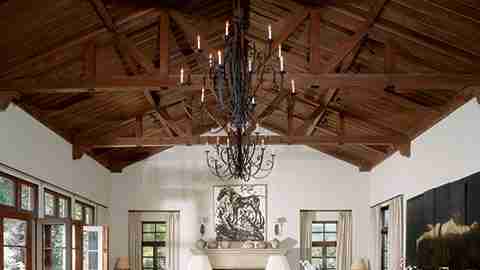View Slideshow

Talking about growing up in Alpena, Michigan, "a kind of summer resort town on Lake Huron," Mariette Himes Gomez sounds something like the narrator in Thornton Wilder's Our Town . "There really weren't a lot of men around. They all seemed to die—of heart attacks and things like that. I guess in a small town they didn't take care of their health the way they do today. But it was a wonderful childhood. We would go to my grandmother's for lunch every Sunday after church. It was pretty idyllic. I don't have any bad memories or sad moments."
Gomez didn't come from the family with the big house on top of the hill. Her mother "didn't have a great deal of money," she explains. "She made doll clothes for a shop that sold handmade things." According to the designer, her mother and her aunt sewed, made hors d'oeuvres, cooked and did spring cleaning. "They could have been modern television personalities who know how to do everything," she says, "the perfect dinner party, the perfect table."
From the age of 14 Gomez knew what she wanted to do. When other girls talked of becoming nurses or teachers, she would say, "I'm going to be an interior designer." None of her friends had any idea what that was. Of her unusual choice of professions, Gomez says, "I suspect I got it from magazines."
"I wanted to take shop drawing, but they wanted me to take home ec. I had to sew something, and it fell apart."
Reading about interior design in magazines is one thing; getting the training is another: "At school I was taught by nuns," she says, and although on the whole she counts that a good experience, it was an education with its own traditions: "I wanted to take shop drawing with the boys, but they wanted me to take home economics with the girls. I remember I had to sew something, and it fell apart."
After graduation, Gomez got a two-year scholarship to a junior college, but the obstacles remained. "You had to take all these other courses," she remembers. "I was just so tired of learning things that I would never use. It wasn't that they weren't going to enrich me, but I knew what I wanted to do. I couldn't see the crossover. Geology! That was a major stretch."
A college instructor suggested that if interior design was what she was interested in, she should visit Detroit or Grand Rapids. So Gomez went to Herman Miller's headquarters and had a tour. "Then I was really hooked."
She was accepted at the Rhode Island School of Design but left there for the New York School of Interior Design. "It wasn't a university and didn't have anything but what I wanted," she says, explaining the switch. "I graduated from there with a bachelor of fine arts." Gomez was not simply a decorator; she had become a designer. "I hate to generalize, and I don't want to set up stereotypes," she emphasizes, "but decorators usually are individuals who prefer to reupholster and do new draperies and pick out furniture." Her office does do decoration but also design work "where we coordinate our services with an architect from the time the building is under construction."
Talking with Mariette Himes Gomez, you realize how much the profession has changed from the era of someone coming to call with swatch books and sketches. Nowadays, the job involves a raft of specialist subcontractors to handle acoustics, lighting and kitchens. In large houses, she says, the kitchen has become a field of its own, with people who "do kitchen after kitchen. They know the current products. They know the availability. They know who's designing new stoves, how to incorporate the pizza oven, the silent dishwashers that wash dishes in 10 minutes, commercial ranges, all the available products in terms of finishes. They even have stone quarries that they use. The millwork for kitchens is the big thing these days," she adds. "Now people prefer the look of an English kitchen, or a French country kitchen, or perhaps an Art Déco kitchen. It's really a vast industry."
Specialization has reached such a point that the designer knows of a company that does nothing but line drawers. "You pick your colors and your papers," she says. "They come and they measure every drawer. First they cover it in cardboard. The kitchen gets one kind of lining that's washable, and there's another lining for the closets and the master suite and the dressing rooms."
On top of being a designer, a decorator and a coordinator of subcontractors, Gomez designs and sells her own line of furniture in addition to her line for Hickory Chair. The furniture particularly delights her when she remembers the good nuns and their conviction that girls belonged in home ec classes. "It's all those things I couldn't do," she says with a laugh. "I couldn't do the drawing classes with the boys or the shop drawing or work the machinery. Now I get to see them carving chair legs and how the upholstery is done and how all the pieces that come in are put together. And I just love it."
